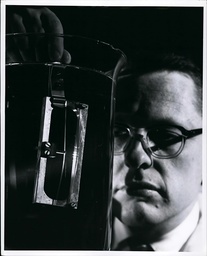Dentists / Doctors / Inventors / Medicine / Science

Nov. 11, 1968 - Tiny ''crazes'' (structural defects in glassy polymers) grow into visible streaks as a stressed sample of plastic is immersed in alcohol in a test by Dr. Roger P. Kambour, a physical chemist at the General Electric Research and Development Center. Dr. Kambour, who has studied the highly complex phenomenon of crazes, has discovered a fundamental relationship between the strength of plastics and a variety of liquids that cause them to crack and break. Like true cracks, crazes reflect light but are really minute regions interlaced with millions of submicroscopic holes. Because of this sponge like nature, crazes become weak points at which cracks and fractures may be generated. Properties of certain liquids increase the tendency of plastics to craze and eventually fracture. (Credit Image: © Keystone Pictures USA/ZUMAPRESS.com)